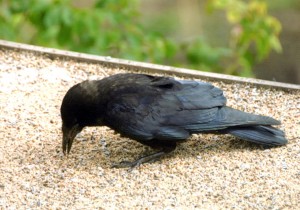 There is a variety of wildlife that is found within the City of Inverness and fortunately most of it is readily seen. The River Ness supports dippers, ducks such as the red breasted merganser and mallard. If you are lucky you can even see otters whilst, to the annoyance of the salmon anglers, the grey seal is relatively easy to see. Grey seals seem almost to play with the fish they catch as if mocking the anglers so intent on plying their rods. Large gardens have a wide variety of birds particularly where bird feeders are well stocked and there you can find also foxes, hedgehogs and even roe deer. But what of the birds in the centre of the city at this time of the year and how do the birds cope when the weather is bad with snow and ice?
There is a variety of wildlife that is found within the City of Inverness and fortunately most of it is readily seen. The River Ness supports dippers, ducks such as the red breasted merganser and mallard. If you are lucky you can even see otters whilst, to the annoyance of the salmon anglers, the grey seal is relatively easy to see. Grey seals seem almost to play with the fish they catch as if mocking the anglers so intent on plying their rods. Large gardens have a wide variety of birds particularly where bird feeders are well stocked and there you can find also foxes, hedgehogs and even roe deer. But what of the birds in the centre of the city at this time of the year and how do the birds cope when the weather is bad with snow and ice?
As I walked around Inverness one day last week these thoughts crossed my mind, mainly because there were two pairs of herring gulls on the top of the buildings in the High Street that sounded as though they were courting rather than anything else. Their raucous cries seemed to vary from loud, laughing and wailing call notes to short barks that the books describe as “kyow kyow, kyow”. That interpretation stretched my imagination but it was perhaps accurate. Herring gulls and to a much lower degree the lesser black-backed gulls can be a nuisance in fouling buildings and even attacking people when the birds have chicks later in the year. Now they are content to scavenge what they can and seem equally at home in the main streets, inside the building of the railway station and in the car parks of large shops. In some of the larger car parks they stand on posts and buildings calling and if one swoops down for food the others see it and follow.
Soaring over some of the inner buildings the large flocks of feral pigeons are conspicuous and they swirl around sometimes in spectacular aerial flights. It is difficult to imagine that all these pigeons originally came from the same source, the rock dove that used to be mainly a coastal bird. Then they were tamed into doocots that at one time played an important part, to well off people, in supplying meat and eggs all the year round. When the much changed, by selective breeding, doocot pigeons escaped once the structures fell into disuse they began breeding with wild rock doves. Now it seems unlikely that there are any true rock doves anywhere in the Highlands, and for that matter the Islands.
Other successful birds to be found in Inverness are the hooded crows and carrion crows. Last week there was a hooded crow that was stalking around the car park in a large supermarket in the middle of the city. As if to indicate the sheer resourcefulness of the bird it was going to parked cars and systematically taking dead insects off the radiators. This was a pure hooded crow as opposed to the carrion crow that is black all over. The two birds are now, as from 2002, classed as two separate “forms” despite the fact that in some areas, such as in and around Inverness, they successfully hybridise. The photograph shows such a hybrid with only small patches of grey feathers. Interestingly the range of the carrion crow has extended in the north of the UK driving the pure hooded crow northwards and westwards. Whatever one thinks of the hooded and carrion crows they have to be admired. Very few other birds could have coped with so much persecution now and in the past by trapping and shooting.
